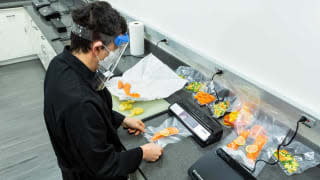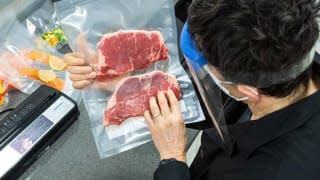Best Vacuum Sealers From Consumer Reports' Tests

Consumer Reports has no financial relationship with advertisers on this site.
Adding a small appliance to your countertop collection is always a calculation. Will you use it? Do you have space for it? Is there a fun factor?
A vacuum sealer checks all those boxes. For starters, these practical little machines save you money by keeping your food fresher, longer. And you can indulge your culinary creativity with sous vide cooking, in which food sealed in a plastic bag is cooked in a water bath.
Vacuum sealers extract air from a bag, then fuse the sides together along a heated strip, creating an airtight seal. If you’ve ever frozen an expensive piece of meat only to find it covered with a thin layer of ice crystals, you’ll appreciate what a vacuum sealer can do. That frosty freezer burn doesn’t make the meat unsafe to eat, but it can change the taste, texture, and appearance.
Ditto for frozen veggies, bread, and just about any other food. You can prevent freezer burn by limiting the food’s exposure to air to reduce oxidation. And sure, you could try tightly wrapping your food in plastic wrap or foil before putting it in a plastic storage bag. But a vacuum sealer is much more efficient and effective.
It’s something you’ll value if you buy your food in bulk or belong to a CSA (Community Supported Agriculture) co-op. “Having whole foods on hand like meat, veggies, and grains is key to a healthy diet,” says Amy Keating, RD, a Consumer Reports nutritionist. “Using a vacuum sealer to maintain fresh ingredients can reduce waste and make these ingredients more accessible for quick, healthy meals.”
What CR's Vacuum Sealer Testing Found

CR tested seven vacuum sealers from six brands. The sealers, $60 to $180, are about as wide as a toaster oven, though most aren’t that tall or deep. The larger models store a roll of plastic onboard, called a bag roll, that you cut to size. Those without roll storage don’t require as much counter space and are even small enough to stash in a drawer.
Some sealers come with a bag roll and/or precut bags in a variety of sizes (such as pint, quart, and gallon). Prices for replacements vary: A batch of 44 quart-sized replacement bags for FoodSaver models costs $21 on the brand’s website, while 100 generic quart-sized bags cost $16 on Amazon. (We tested two generic brands, and they worked with all the sealers in our tests.)
In previous tests, we evaluated whether vacuum sealing extended the storage life of food. “The answer to that was a resounding ‘Yes,’ so we didn’t feel the need to repeat those tests,” says CR test engineer Bernie Deitrick. So we focused on how well a model seals dry food (such as an uncooked chicken breast or steak), how well it seals moist food (think meat in a marinade), how fast it works, how quietly it operates, and whether it’s simple to clean and has such convenience features as cord and bag roll storage, and has easy-to-understand controls.
Top Vacuum Sealers

All seven vacuum sealers CR tested were top-notch at dry sealing, earning an Excellent rating on that test. But beyond that, we found real differences. Read on for ratings and reviews of the top three vacuum sealers from our tests. To see the entire list, check CR’s full vacuum sealer ratings and recommendations.
FoodSaver VS3180 Multi-Use
Known for its late-night infomercials in years past, FoodSaver is still a major player in this market. The FoodSaver VS3180 Multi-Use is almost as good at sealing moist food as sealing dry, and it operates quickly. Its noise scores are so-so, but the FoodSaver is the only sealer of the seven we tested to earn an Excellent rating on our ease-of-use test. It latches with a lever, and the controls are easy to understand, though the unsealed buttons may collect debris. There is handy storage for the bag roll and cord, and it’s a cinch to clean. Both of the gaskets that hold the bag in place for sealing can be removed for cleaning, and the catch basin that collects any stray liquid can be taken out and emptied. A nice add-on: an accessory port that makes it possible to vacuum seal lidded containers (that you buy separately).
Dimensions: 6x16x9 inches (height x width x depth)
Comes with: 12 quart bags, 10 gallon bags, and a bag roll that’s 8 feet long and 11 inches wide
Hamilton Beach NutriFresh 78220
The Hamilton Beach NutriFresh 78220 is another good choice if you like to marinate food, earning a Very Good rating on our moist sealing test. It operates quickly, which you’ll appreciate if you’re sealing multiple bags of food to freeze. It doesn’t notch a perfect ease-of-use score but comes close. To latch the unit, you press the top down firmly and press two buttons on the sides. Once the cycle is complete, the latch releases automatically. The controls are sealed, making them easy to clean, and both gaskets can be removed for cleaning, though the catch basin must be cleaned in place. There’s ample storage for both the cord and the bag roll.
Dimensions: 6x17x10 inches (height x width x depth)
Comes with: 6 quart bags, 4 gallon bags, and a bag roll that’s 8 feet long and 11 inches wide
Anova Culinary ANVS01-US00
The Anova Culinary ANVS01-US00 is sold as a companion to Anova’s sous vide tool, which we tested previously. It’s the smallest of all the vacuum sealers we tested. It’s also the quietest and the only model to earn an Excellent rating on our noise test. It seals quickly and can handle moist sealing with aplomb. The only thing holding it back? Its lackluster ease-of-use score. Only the bottom gasket can be removed for cleaning, and the catch basin must be cleaned in place. Of the seven models we tested, this is the only one that doesn’t come with a bag roll, though you can buy one separately. There’s no onboard storage for a bag roll, a trade-off made to reduce the size of the unit.
Dimensions: 3x17x5 inches (height by width by depth)
Comes with: 10 quart bags
